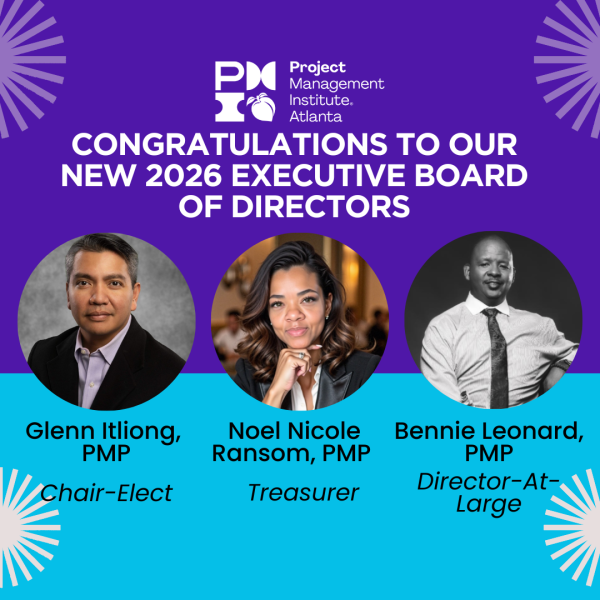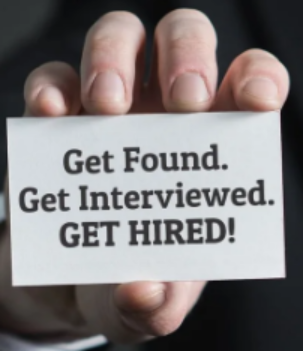The PMI Atlanta Chapter would like to welcome our new members who will serve on the 2026 Executive Board of Directors. Please plan to join us at the Holiday Celebration on Monday, December 8, 2025 at Magginao's Buckhead.
Meet the New Board Members

Chair-Elect
 Glenn Itliong, PMP
Glenn Itliong, PMP
Born in the Philippines and raised between Manila and Lusaka, Zambia, I bring a multicultural perspective shaped by a globally diverse upbringing. I attended an English boarding school for high school, where I was introduced to a rigorous academic environment and a rich mix of cultures. I went on to earn a B.A. in International Relations and Philosophy from Saint Joseph’s University in Philadelphia, where I was honored with the President’s Award for Community Service for my volunteer work with Habitat for Humanity. To deepen my leadership and business expertise, I later completed an Executive MBA at Saint Mary’s College in Moraga, California. Professionally, I serve as a Senior Project Manager specializing in SaaS and IT implementations across global markets. I have successfully led complex implementations in the United Kingdom, India, Poland, Canada, and the United States, helping organizations streamline operations, adopt new technologies, and drive digital transformation. My work combines a strategic mindset with cultural fluency, enabling me to lead cross functional teams and deliver results in diverse environments. Outside of work, I’m a proud husband to my wonderful wife Candace and the father of two spirited children — Jackson (6) and Ella (3) — who keep me inspired, grounded, and on my toes every day.
Volunteer Experience
Throughout my academic and professional journey, service has been a cornerstone of my identity. I’ve contributed time, leadership, and professional expertise to a wide range of mission-driven organizations, with a particular focus on housing, youth engagement, and nonprofit strategy. My most extensive volunteer experience has been with Habitat for Humanity, where I led numerous student groups on home-building projects in underserved communities. While attending Saint Joseph’s University in Philadelphia, I organized and led weekend work crews of undergraduate and graduate students to housing sites in Southwest Philadelphia. These projects provided safe housing for local families while building a strong culture of purpose-driven leadership among students. Expanding on that commitment, I later organized, funded, and led a Spring Break service trip to Freeburn, Kentucky, a rural Appalachian community in need of affordable housing. I managed all trip logistics, fundraising, and volunteer coordination, allowing our team to contribute directly to new home construction efforts in one of the nation’s most economically challenged regions. In 1995, I was honored with a National Volunteer Commendation award signed by President Bill Clinton, recognizing my leadership and service through Habitat for Humanity. This award remains one of my proudest early acknowledgments of civic impact. Beyond Habitat, I have continued to serve in varied capacities. In San Francisco, I supported Sports4Good, a nonprofit that uses athletics to engage youth and raise funds for social causes, by helping to organize community sporting events. I’ve also offered pro bono consulting to nonprofit organizations, including Activate Good in Raleigh, NC, where I helped optimize their volunteer engagement and outreach strategy. Through my consulting practice, Process Mavericks, I continue to offer pro bono project management services to nonprofits, helping them improve operations, build capacity, and deliver greater impact. These experiences reflect a lifelong belief in using both leadership and service to build stronger communities.
Vision Statement
I envision the PMI Atlanta Chapter as a driving force for professional excellence, community connection, and strategic leadership.
If selected as Chair-Elect, my goal is to help expand the chapter’s reach, support our leadership team, and ensure PMI Atlanta continues to be a trusted hub for project professionals across the region.
With a background as a Senior Project Manager leading global SaaS and IT implementations across the U.S., UK, India, Poland, and Canada, I bring practical experience in aligning teams, managing risk, and delivering results across diverse environments.
I will leverage this experience to support chapter strategy; mentor as needed and help oversee sound financial and operational planning. My leadership style is rooted in service.
From receiving President Bill Clinton’s commendation for my volunteer work with Habitat for Humanity to providing pro bono consulting through my firm, I’ve consistently invested in helping others succeed.
I believe PMI Atlanta can grow its impact not just through events and networking, but by fostering meaningful mentorship, relationship building and hands-on community engagement.
As Chair-Elect, I will represent the chapter with professionalism, integrity and unbridled enthusiasm — championing its mission, supporting our volunteers, and helping guide strategic initiatives that serve both our members and the broader Atlanta business community.
Together, we can continue to build a chapter that’s innovative, inclusive, and inspiring — one that empowers every member to lead with purpose and deliver with confidence.
Treasurer
 Noel Nicole Ransom, PMP
Noel Nicole Ransom, PMP
With over 18 years of experience leading transformative initiatives, I have dedicated my career to empowering teams, elevating organizational performance, and driving measurable results. As a PMP-certified Project Management Professional since 2013, a Lean Six Sigma Master Black Belt, and a proud member of PMI and the PMI Atlanta Chapter for more than eight years, I bring both deep expertise and a passion for advancing our profession. In my current role as Vice President of Implementation at Meridian Cooperative, I lead enterprise-wide technology migrations and process optimization programs, building trust across diverse teams and delivering operational excellence. Previously, I served as Senior Director of IT Strategy & Operations Management for Beazer Homes, and Senior Director of Process at FORTNA, where I established and led the Enterprise PMO, overseeing ERP and SaaS implementations that transformed business operations. Beyond corporate leadership, I am committed to sharing knowledge and inspiring others. I am the author of The Accidental Leadership Series, including Project Management Foundations: A Guide for the Accidental Project Manager, and am completing my Doctorate in Business Administration with a concentration in project management and process improvement. My doctoral research explores the relationship between project management methodologies, Lean Six Sigma, and cost reduction in manufacturing projects. An Atlanta native, I balance my professional life with community involvement, mentoring, and supporting local initiatives. Whether in the boardroom, the classroom, or the community, I lead with purpose, collaboration, and an unwavering commitment to excellence
Volunteer Experience
Throughout my career, service has been a constant thread—whether in professional associations, education, or community impact initiatives. My volunteer work has allowed me to mentor, teach, and inspire others while strengthening the organizations I support. As a long-standing member of PMI and the PMI Atlanta Chapter, I have actively participated in chapter events, networking sessions, and professional development programs, often serving informally as a connector between members, local businesses, and project professionals. My contributions include mentoring emerging project managers, sharing best practices on Lean Six Sigma and Agile methodologies, and advising peers on career growth strategies. In my role as an adjunct instructor for Emory University’s Continuing Education Program and other professional learning platforms, I have volunteered time beyond the classroom to coach students, review resumes, and guide them toward PMI certifications. Many of my students have successfully earned their PMP or Lean Six Sigma certifications and advanced their careers. I have also given my expertise to alumni networks, including the International Clark Atlanta Alumni Network, where I help create engagement strategies, facilitate events, and encourage alumni to give back to their alma mater. Beyond the professional sphere, I have served as a mentor and supporter in youth sports programs, including the Level Up Basketball Academy, where I assist with event planning, fundraising, and mentorship. Additionally, I frequently volunteer with local charities, faith-based initiatives, and community projects, offering both my professional skills and hands-on support. Across all volunteer roles, my focus remains on empowerment and sustainability—helping individuals and organizations build the skills, strategies, and structures they need to thrive long after my direct involvement. I believe volunteering is not just about giving time; it’s about leaving a lasting impact that multiplies through the success of others.
Vision Statement
My vision for the PMI Atlanta Chapter is to be the premier hub for project leadership, professional growth, and innovation in our region—where members not only earn credentials but also build lasting connections, expand their influence, and make a measurable impact on their organizations and communities.
As Treasurer, I will focus on three key pillars:
- Financial Stewardship – Safeguarding our chapter’s resources through transparent, accountable, and strategic financial management that ensures long-term stability and growth. This includes implementing sound budgeting practices, enhancing financial reporting, and ensuring funds are invested back into member value.
- Engagement & Empowerment – Using financial planning to expand opportunities for members to connect meaningfully—funding mentorship programs, collaborative projects, and learning pathways that equip members with advanced skills in project management, Lean Six Sigma, and emerging methodologies.
- Visibility & Sustainability – Positioning PMI Atlanta as a recognized voice and thought leader by aligning financial decisions with our chapter’s strategic goals. I will work to amplify our presence in local business forums, highlight the impact of member contributions, and ensure our resources fuel both chapter growth and community impact.
With 18+ years of experience leading enterprise transformations, a strong foundation in finance and accounting, and a passion for professional development, I am committed to ensuring that PMI Atlanta continues to grow in influence, reach, and value. Together, we will foster a chapter that doesn’t just keep pace with change—we will lead it with both vision and financial integrity.
Director-at-Large
 Bennie Leonard, PMP
Bennie Leonard, PMP
I am a Dynamic, enthusiastic, and results-driven Program Manager with a strong track record of leading high-impact, multimillion-dollar organizational change and agile digital transformation initiatives across global organizations.
Volunteer Experience
I have served as the Vice President of Professional Growth for PMI Atlanta for 5 years. Under my leadership, we have certified 50 new PMPs, provided 150 mentors, and effectively served the community though the Social Impact Committee. I served as the host for the PMI Atlanta 40th anniversary celebration honoring our great organization.
Vision Statement
Atlanta is a thriving hub of untapped project management talent. In my four years as VP of Professional Growth, I’ve had the privilege of working alongside passionate professionals who’ve transformed our community—certifying hundreds through the PMI pipeline and creating meaningful opportunities for
growth. Yet, we’ve only begun to tap the potential that surrounds us.
My vision is to work arm-in-arm with the PMI Atl LMT and expand our reach, deepen our impact, and elevate PMI Atlanta as the premier destination for project management excellence. I will champion a bold, inclusive strategy that:
- Activates dormant potential by engaging PMI members who haven’t yet found their place in our programs.
- Welcomes new voices by recruiting certified professionals outside our chapter and inviting them into our vibrant community.
- Incorporates best practices from across the nation—cost-effective, high-impact initiatives like resume building, interview coaching, social media strategy, and personal development workshops.
- Bridges opportunity and talent by connecting employers with our members and building a robust career advancement pipeline.
We are a volunteer-powered organization with a strong foundation. My vision is to grow that foundation—adding new leaders, fresh perspectives, and innovative programs that reflect the diversity and dynamism of Atlanta’s professional landscape. Together, we’ll build a chapter that not only serves but inspires.










